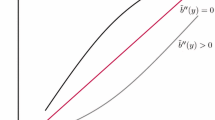Abstract
A game-theoretical model is constructed describing the interaction of tax inspectors with taxpayers. The models allows for tax evasion and bribing of inspectors. We find the primary and secondary audit probabilities that maximize the net tax revenue for various inspector hiring strategies. The comparative revenue statics is analyzed and the optimal hiring strategy is determined as a function of the model parameters.
Similar content being viewed by others
REFERENCES
P. Chander and L. Wilde, “Corruption in tax administration,” J. Public Econ., 49, 333-349 (1992).
F. Cowell and G. F. Gordon, “Auditing with 'ghosts',” in: The Economics of Organized Crime (1995), pp. 184-198.
I. Sanchez and J. Sobel, “Hierarchical design and enforcement of income tax policies,” J. Public Econ., 50, 345-369 (1993).
J. Hindriks, M. Keen, and A. Muthoo, “Corruption, Extortion, and Evasion,” J. Public Econ., 74, No. 3, 395-430 (1999).
J. Tirole, “Collusion and the theory of organizations,” in: J.-J. Laffont, (ed.), Advances in Economics Theory: Sixth World Congress, Cambridge Univ. Press (1992).
A. A. Vasin and E. I. Panova, Tax Collection and Corruption in Tax Administration [in Russian], Russian Program of Economic Studies No. 99/10, Moscow (2000).
Rights and permissions
About this article
Cite this article
Vasin, A.A., Navidi, K. Optimal Tax Inspection Strategy. Computational Mathematics and Modeling 14, 160–172 (2003). https://doi.org/10.1023/A:1022959607712
Issue Date:
DOI: https://doi.org/10.1023/A:1022959607712




